
Jane Austen was an English novelist known primarily for her six major novels, which interpret, critique, and comment upon the British landed gentry at the end of the 18th century. Austen's plots often explore the dependence of women on marriage in the pursuit of favourable social standing and economic security. Her works critique the novels of sensibility of the second half of the 18th century and are part of the transition to 19th-century literary realism. Her use of social commentary, realism and biting irony have earned her acclaim among critics and scholars.

George Bryan "Beau" Brummell was an important figure in Regency England, and for many years he was the arbiter of British men's fashion. At one time, he was a close friend of the Prince Regent, the future King George IV, but after the two quarrelled and Brummell got into debt, he had to take refuge in France. Eventually, he died shabby and insane in Caen.

Lady Charlotte Susan Maria Bury was an English novelist, who is chiefly remembered in connection with a Diary illustrative of the Times of George IV (1838).
Henry Colburn was a British publisher.
Fashionable novels, also called silver-fork novels, were a 19th-century genre of English literature that depicted the lives of the upper class and the aristocracy.
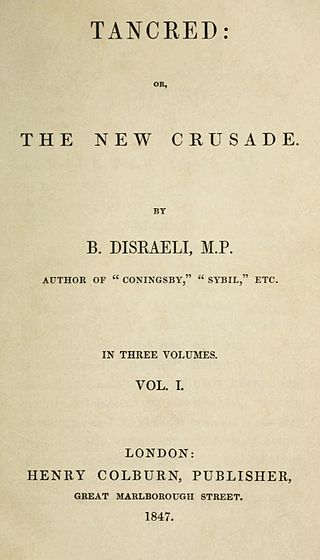
Tancred; or, The New Crusade (1847) is a novel by Benjamin Disraeli, first published by Henry Colburn in three volumes. Together with Coningsby (1844) and Sybil (1845) it forms a sequence sometimes called the Young England trilogy. It shares a number of characters with the earlier novels, but unlike them is concerned less with the political and social condition of England than with a religious and even mystical theme: the question of how Judaism and Christianity are to be reconciled, and the Church reborn as a progressive force.
Catherine Dorothea Burdett was an Irish novelist who drew mainly on personal experience.

The Separation is an 1830 novel by the British writer Lady Charlotte Bury, published in three volumes. It falls into the tradition of silver fork novels, popular at the time. It was published in New York by Harper the same year in two rather than three volumes. It was published anonymously, although Bury's authorship was widely known. A reviewer attacked it for recycling the plot entirely from Bury's 1812 novel Self-indulgence, although the resulting publicity seemed to help the novel's sales.

Flirtation is an 1827 novel by the British writer Lady Charlotte Bury, originally published in three volumes. Bury, writing anonymously, was a well-known author of silver fork novels set in high society. It was a popular success and quickly ran through three editions.

The Disowned is a novel by the British writer Edward Bulwer-Lytton, originally published in three volumes. It is part of the then-popular genre of silver fork novels, focusing on British high society of the late Regency era. Like many other silver fork novels it was published by Henry Colburn, with the first volume coming out in 1828 and the latter two in 1829. It is set in the late eighteenth century but the political and social themes it refers to have more relevance to the contemporary 1820s.

Devereux is an 1829 historical novel by the British writer Edward Bulwer-Lytton, published in three volumes. It takes place during the reign of Queen Anne and partly revolves around a secret Jacobite plot to place the pretender James Stuart on the throne. He earned £1,500 for the novel from his publisher Henry Colburn, trebling his earnings from the successful silver fork novel Pelham of the previous year. He dedicated it to his friend the Canadian traveller and writer John Auldjo, then living in Naples. The story of a sibling rivalry between three brothers may have been influenced by Bulwer-Lytton's own upbringing.
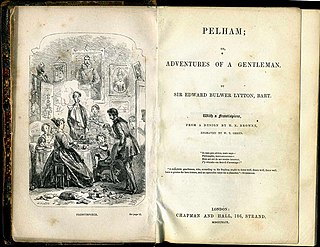
Pelham is an 1828 novel by the British writer Edward Bulwer-Lytton, originally published in three volumes. It was his breakthrough novel, launching him as one of Britain's leading authors. It is part of the tradition of silver fork novels that enjoyed great popularity in the late Regency and early Victorian eras. It follows the adventures of Henry Pelham, a young dandy, in Paris, London and the fashionable spa town of Cheltenham.
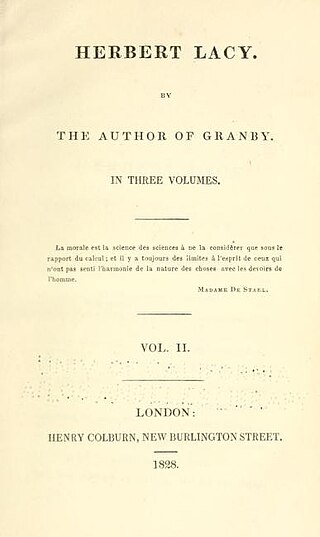
Herbert Lacy is an 1828 novel by the British writer Thomas Henry Lister, originally published in three volumes. It was part of the then-popular genre of silver fork novels depicting life in the high society of late Regency Britain. It was his second novel following Granby (1826). Much of the plot revolves around politics, with the title character elected to Parliament. It also examines the alliance between the aristocracy and growing middle classes Like many of the silver fork novels it was published by Henry Colburn.

Falkland is an 1827 Gothic novella by the British writer Edward Bulwer-Lytton. It was his first published novel and took inspiration from Johann Wolfgang Goethe's The Sorrows of Young Werther. The protagonist was likely partly based on Bulwer-Lytton himself. The novel enjoyed success in Germany, but was criticised in Britain as immoral. It was followed by Pelham in 1828, in which he switched to the fashionable silver fork genre, which established him as leading writing in Britain and Europe.
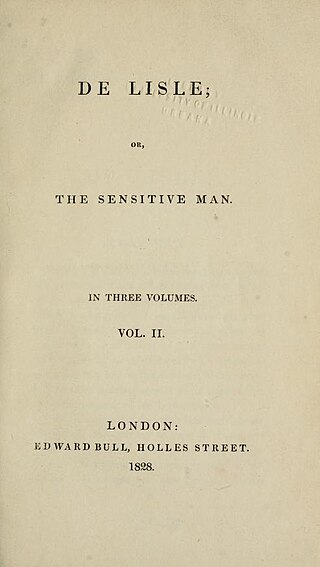
De Lisle is an 1828 novel by the British writer Elizabeth Caroline Grey, originally published in three volumes. It is part of the then-fashionable genre of silver fork novels set amongst the British upper classes during the later Regency era. It revolves around the marriage of the protagonist Hubert De Lisle to Lady Rosamond Trevannon. Although a good and faithful wife, her increasingly neurotic husband becomes extremely suspicious of her.

Yes and No is an 1828 novel by the British writer and politician Lord Normanby, originally published in two volumes. It was part of the popular genre of silver fork novels which focused on the British upper classes in the later Regency era. It was his second published work following Matilda in 1825. The novel focuses heavily on the politics of Britain in the late 1820s, focusing on three main protagonists and examining the Whigs, liberal Tories, and Ultra-Tories.

Matilda is an 1825 novel by the British writer and politician Lord Normanby, originally published in two volumes. It was part of the emerging, popular genre of silver fork novels which focused on the fashionable British upper classes in the later Regency era, and was his first published work. He followed it with a second silver fork novel, the political Yes and No in 1828.

The Contrast is an 1832 novel by the British writer and politician Lord Normanby, originally published in three volumes. It was his third novel following Matilda (1825) and Yes and No (1828), all three of which were part of the developing silver fork genre focused on the fashionable aristocracy and upper classes of the late Regency period. It was written at the time of the Reform Act and examines the mixing of relationships across classes.
Granby is an 1826 novel by the British writer Thomas Henry Lister, published in three volumes. His first novel, it was part of the emerging genre of silver fork novels which take place in fashionable upper class settings of Regency Britain.
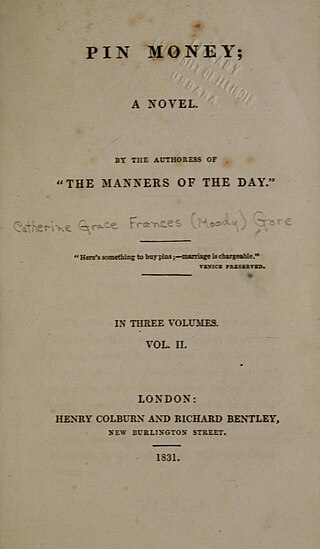
Pin Money is an 1831 novel by the British writer Catherine Gore, originally published in three volumes. It was part of the group of silver fork novels published during the later Regency era that focuses on life in the fashionable British upper classes. The Westminster Review considered the male characters to be more skilfully drawn than the female. Another review suggested that there was too much product placement in the novel, advertising the goods of various London shops.
















